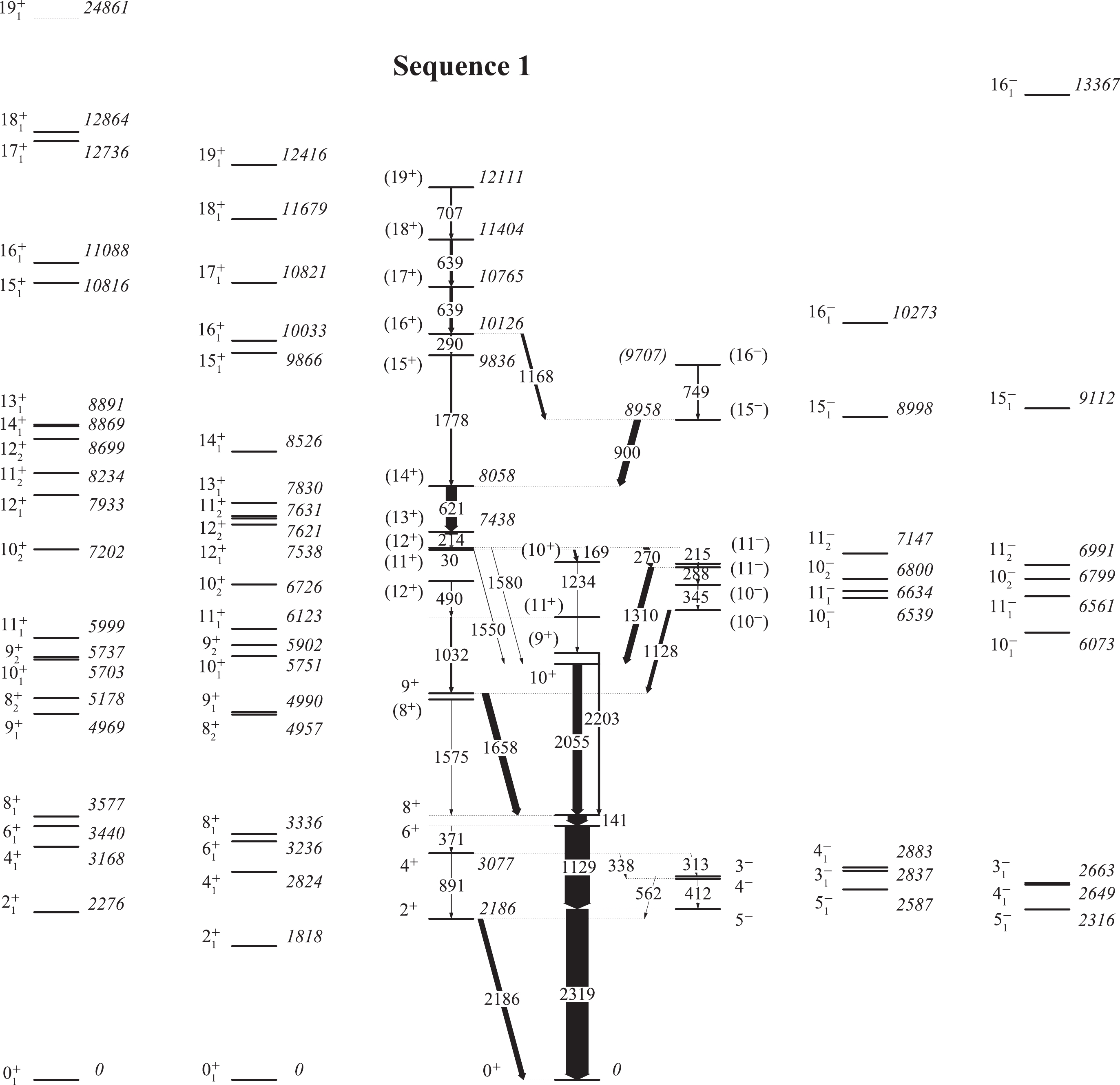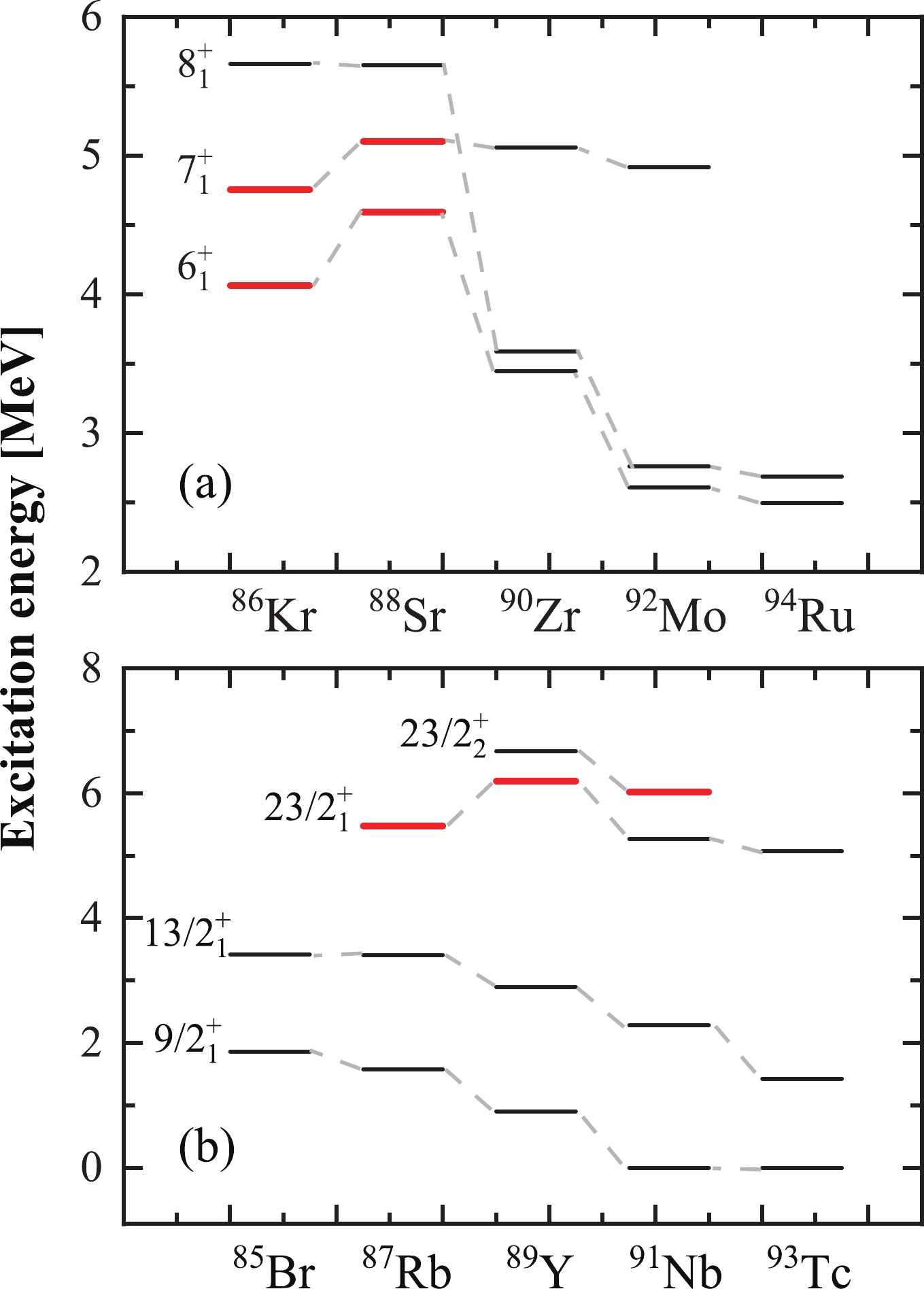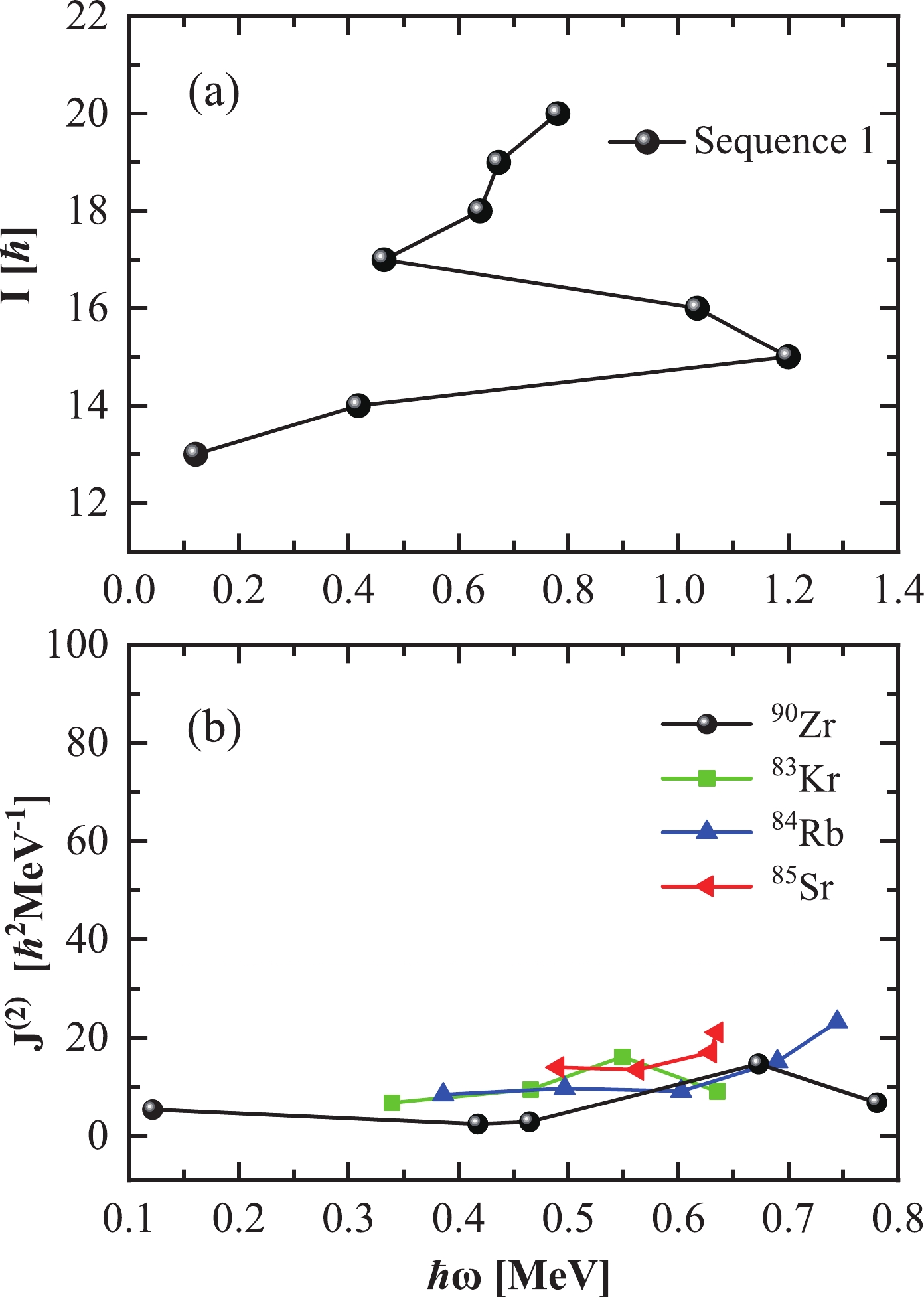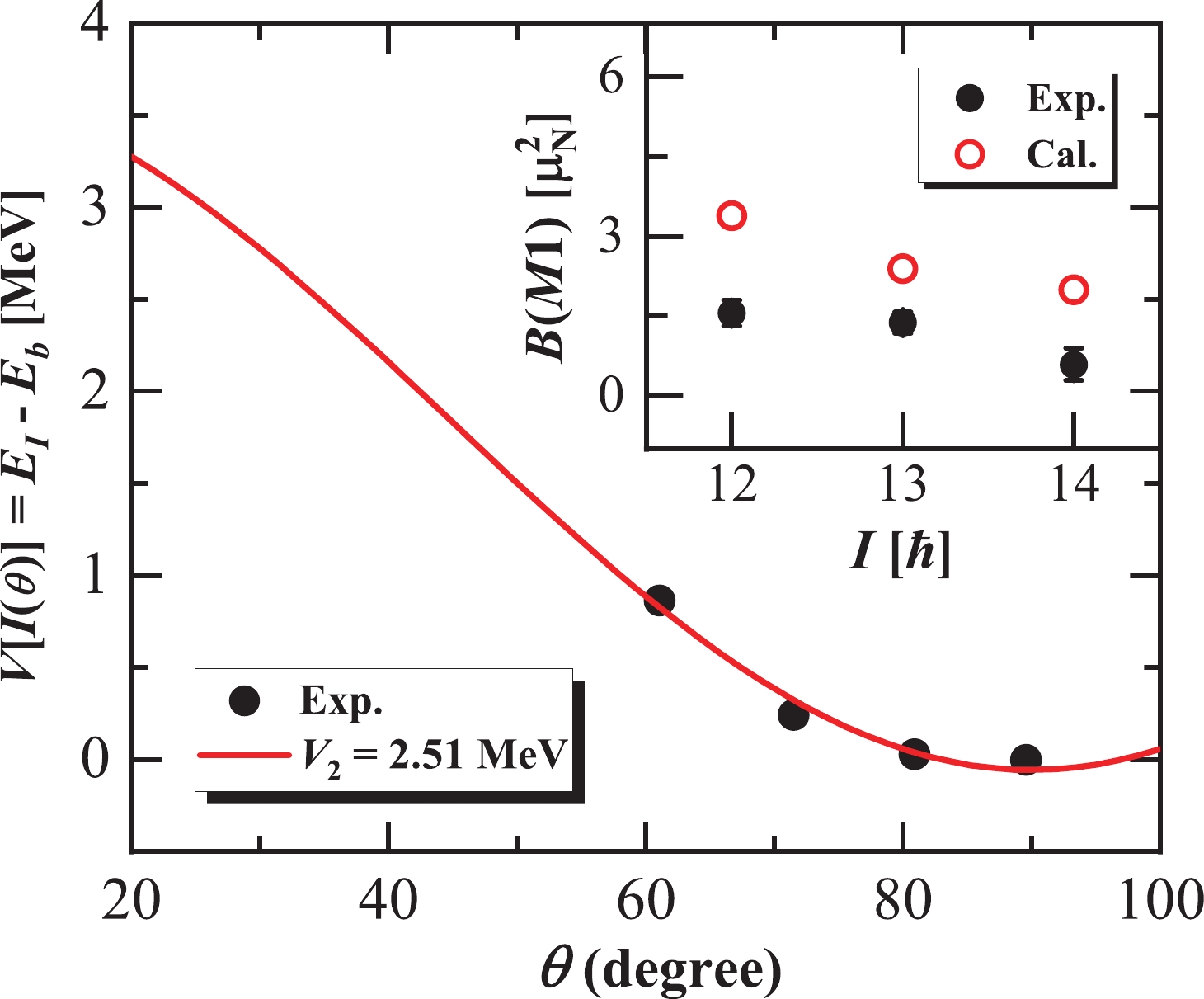HTML
--> --> -->In addition, the magnetic rotation is another significantly interesting topic in our current study. It can be sufficiently interpreted by the tilted axis cranking covariant density functional theory (TAC-CDFT) [27-30]. In addition, semiclassical calculations can also provide a logical description for the shears mechanism [31-34]. In the A
2
A.Proton excitations and neutron core breaking
The level scheme of 90Zr deduced from Ref. [23] and the results of the shell model calculations (SM1 and SM2) are compared in Fig. 1. The main partitions of the wave function for each state within SM1 and SM2 are summarized in Table 1. Figure1. Level scheme of 90Zr deduced from Ref. [23], compared with the results obtained from the shell model calculations (SM1 and SM2).
Figure1. Level scheme of 90Zr deduced from Ref. [23], compared with the results obtained from the shell model calculations (SM1 and SM2).  |   | SM1 | SM2 | |||||||
  | Wave function   | Seniority ν | Partitions (%) |   | Wave function   | Seniority ν | Partitions (%) | |||
  | 0 | 0 | 6 4 2 0   | 0 | 45.25 | 0 | 6 4 2 0   | 0 | 30.26 | |
6 4 0 2   | 0 | 22.45 | 6 4 0 2   | 0 | 20.89 | |||||
  | 2186 | 2276 | 6 4 0 2   | 2 | 50.68 | 1818 | 6 4 0 2   | 2 | 36.62 | |
4 4 2 2   | 2 | 16.21 | 4 4 2 2   | 2 | 16.69 | |||||
  | 3077 | 3168 | 6 4 0 2   | 2 | 54.83 | 2824 | 6 4 0 2   | 2 | 40.93 | |
4 4 2 2   | 2 | 14.36 | 4 4 2 2   | 2 | 15.55 | |||||
  | 3448 | 3440 | 6 4 0 2   | 2 | 59.52 | 3236 | 6 4 0 2   | 2 | 48.94 | |
4 4 2 2   | 2 | 12.43 | 4 4 2 2   | 2 | 14.05 | |||||
  | 3589 | 3577 | 6 4 0 2   | 2 | 63.07 | 3336 | 6 4 0 2   | 2 | 50.65 | |
4 4 2 2   | 2 | 12.07 | 4 4 2 2   | 2 | 13.48 | |||||
  | 5164 | 5178 | 5 4 1 2   | 2 | 47.53 | 4957 | 5 4 1 2   | 4 | 40.82 | |
5 3 2 2   | 2 | 25.20 | 6 3 1 2   | 4 | 19.89 | |||||
  | 5247 | 4969 | 5 4 1 2   | 4 | 73.08 | 4990 | 5 4 1 2   | 4 | 66.91 | |
5 3 2 2   | 4 | 11.91 | 5 3 2 2   | 4 | 10.64 | |||||
  | 5792 | 5737 | 6 3 1 2   | 4 | 67.49 | 5902 | 5 4 1 2   | 4 | 44.86 | |
5 4 1 2   | 4 | 13.93 | 6 3 1 2   | 4 | 21.38 | |||||
  | 5644 | 5703 | 5 4 1 2   | 4 | 76.91 | 5751 | 6 3 1 2   | 4 | 38.86 | |
5 3 2 2   | 4 | 13.72 | 5 4 1 2   | 4 | 20.99 | |||||
  | 7026 | 7202 | 4 4 0 4   | 4 | 55.80 | 6726 | 4 4 0 4   | 4 | 48.21 | |
4 4 2 2   | 4 | 8.65 | 4 3 1 4   | 4 | 7.85 | |||||
  | 6280 | 5999 | 5 4 1 2   | 4 | 73.52 | 6123 | 5 4 1 2   | 4 | 65.31 | |
5 3 2 2   | 4 | 14.18 | 5 3 2 2   | 4 | 12.46 | |||||
  | 7194 | 8234 | 4 4 0 4   | 4 | 34.60 | 7631 | 6 4 0 2   | 4 | 34.74 | |
5 3 0 4   | 4 | 24.19 | 4 4 2 2   | 4 | 16.23 | |||||
  | 6770 | 7933 | 4 4 0 4   | 4 | 62.69 | 7538 | 4 4 0 4   | 4 | 51.58 | |
4 3 1 4   | 6 | 12.98 | 4 3 1 4   | 6 | 10.90 | |||||
  | 7224 | 8699 | 5 3 0 4   | 4 | 29.17 | 7621 | 6 4 0 2   | 4 | 38.10 | |
4 4 0 4   | 4 | 26.84 | 4 4 2 2   | 4 | 17.05 | |||||
  | 7438 | 8891 | 5 3 0 4   | 6 | 38.03 | 7830 | 6 4 0 2   | 4 | 42.29 | |
4 4 0 4   | 6 | 33.83 | 4 4 2 2   | 4 | 17.69 | |||||
  | 8058 | 8869 | 4 4 0 4   | 6 | 70.98 | 8526 | 6 4 0 2   | 4 | 40.74 | |
4 3 1 4   | 6 | 22.62 | 4 4 2 2   | 4 | 14.72 | |||||
  | 9836 | 10816 | 5 3 0 4   | 6 | 29.71 | 9866 | 5 4 1 2   | 6 | 54.25 | |
5 2 1 4   | 6 | 22.90 | 4 4 2 2   | 6 | 7.32 | |||||
  | 10126 | 11088 | 5 3 0 4   | 6 | 38.12 | 10033 | 5 4 1 2   | 6 | 73.92 | |
5 2 1 4   | 8 | 27.82 | 5 3 2 2   | 6 | 13.27 | |||||
  | 10765 | 12736 | 3 4 1 4   | 8 | 53.79 | 10821 | 5 4 1 2   | 6 | 66.57 | |
4 3 1 4   | 8 | 32.73 | 5 3 2 2   | 6 | 14.64 | |||||
| Continued on next page | ||||||||||
Table1.Main partitions of the wave functions for 90Zr with SM1 and SM2 configuration spaces. The wave function for a particular angular momentum state would contain several partitions. Each partition is of the form
It can be seen from Fig. 1 that the
In Table 1, it can be observed that the primary contribution to the positive-parity states from the
It can be seen from Fig. 1 that the predicted energies of the
The improved description for the
A similar situation also emerges in the negative-parity states of 90Zr. As can be seen from Fig. 1, the calculations within SM2 containing neutron core excitations provide an improved description for higher-spin states in comparison with the SM1. Hence, the breaking of the N = 50 core plays an important role in the higher-spin states of 90Zr, for positive-parity states as well as negative-parity states. The calculated
2
B.Evolution from the neutron core excitations to proton excitations
The core excitations are systematically observed in N = 50 isotones, generally for the higher-spin states. However, we note that some specific lower-spin states also include the breaking of the N = 50 core. To further understand the core breaking of the lower-spin states, the systematic study of the states for the N = 50 even-even isotones 86Kr [47], 88Sr [6], 90Zr [23, 48], 92Mo [9], 94Ru [11], and odd-A isotones 85Br [49], 87Rb [50], 89Y [7], 91Nb [8], 93Tc [10], is presented in Figs. 2(a) and 2(b), respectively, where the states, including the neutron core excitations, are marked in red. Figure2. (color online) Excitation energies for the low-lying states in the N = 50 (a) even-even isotones 86Kr [47], 88Sr [6], 90Zr [23, 48], 92Mo [9], and 94Ru [11], and (b) odd-A isotones 85Br [49], 87Rb [50], 89Y [7], 91Nb [8], and 93Tc [10]. The states including the neutron excitations across the N = 50 core are marked in red.
Figure2. (color online) Excitation energies for the low-lying states in the N = 50 (a) even-even isotones 86Kr [47], 88Sr [6], 90Zr [23, 48], 92Mo [9], and 94Ru [11], and (b) odd-A isotones 85Br [49], 87Rb [50], 89Y [7], 91Nb [8], and 93Tc [10]. The states including the neutron excitations across the N = 50 core are marked in red.In Fig. 2(a), the
This indicates an evolution from the neutron core excitations to proton excitations for low-lying states, along the N = 50 even-even isotones. This phenomenon appears to be related to the change in the proton Fermi surface. With the decrease in the proton number from 90Zr to 86Kr, the proton Fermi surface moves away from the
A similar situation also emerges at the 23/
In addition, for the
2
C.Possible magnetic rotation
In Fig. 1, the positive-parity sequence 1 primarily comprises relatively strong M1 transitions with absent E2 crossover transitions. To further interpret this sequence, the observed spins I are presented in Fig. 3(a) as a function of the rotational frequency Figure3. (color online) (a) Angular momentum as a function of rotational frequency
Figure3. (color online) (a) Angular momentum as a function of rotational frequency In this mass region, the high-j particles and holes are known to play active roles in the magnetic rotation [35]. In fact, these basic conditions for the occurrence of magnetic rotation can be satisfied in the positive-parity sequence 1. Hence, it is interesting to investigate whether sequence 1 emerges from magnetic rotation. Accordingly, the dynamic moment of inertia
 Figure4. Comparison of transition rates
Figure4. Comparison of transition rates In order to examine the conjecture of magnetic rotation, the theoretical reduced transition probabilities
 Figure5. (color online) Effective interaction as a function of shears angle. The solid curve represents the fit to the experimental data for
Figure5. (color online) Effective interaction as a function of shears angle. The solid curve represents the fit to the experimental data for To further elucidate the shears mechanism, we perform the semiclassical calculations proposed by A. O. Macchiavelli and R. M. Clark et al. [31-34], based on a schematic model with the objective of extracting information on the effective interaction. The calculated energies of sequence 1 are presented as a function of shears angle θ, in comparison with the available data, as illustrated in Fig. 5, where the shears angle decreases gradually with spin increasing. In addition, the data are logically reproduced for





